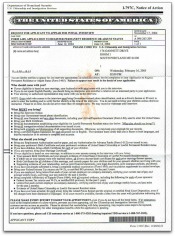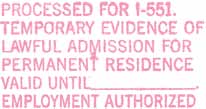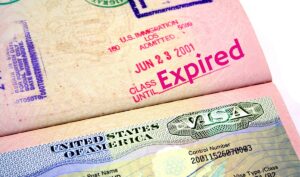
A foreign national spouse of a U.S. citizen who is also inside the United States can generally apply for a green card without leaving the U.S. This process, known as adjustment of status, concludes with an interview. U.S. Citizenship and Immigration Services (USCIS) interviews virtually every applicant for a marriage-based green card. Upon completion of a successful marriage-based adjustment of status interview, the applicant will generally become a permanent resident (green card holder). Every couple should prepare for this interview. Knowing what to expect, what items to take, and how to respond to questions will improve your chances of a quick approval.
After filing a marriage-based Form I-485, Application to Adjust Status, there are generally two appointments. USCIS will schedule a biometrics appointment for the applicant (usually within the first couple of months) and then the interview appointment several months later. USCIS requires both spouses (the applicant and petitioner) to attend the marriage-based adjustment of status interview.
Interview Appointment Notice

You’ll know it’s time for your interview when USCIS mails the applicant the interview appointment notice. Like many other USCIS communications, the appointment notice will be labeled as I-797C Notice of Action.
They mail the notice for your marriage-based adjustment of status interview a few months into the I-485 time line. You’ll have a few weeks to prepare and make travel arrangements (if necessary). Although you mailed your application to a USCIS lockbox location, they will schedule an interview at a local office nearest you. In some areas of the country, this may require a long drive and an overnight stay.
RECOMMENDED: Form I-485 Processing Time
Before the Interview
Review your applications and all supporting documents
If you followed the directions in your CitizenPath filing instructions, you’ll have a photocopy of each application and the supporting documents you submitted with them. Review all of these documents. Make sure the information is consistent. Has anything changed? Be familiar with the information and ready to answer questions. The USCIS officer will analyze the dates, places of residence, employment and other facts.
Discuss the facts of your relationship
Spend some time with your spouse discussing the history of your relationship. Make sure you remember your initial meeting the same way. Review the facts and circumstances surrounding your relationship, such as where and how you met, how your relationship developed, who proposed and how, how the family accepted your relationship, any special things you like to do together, etc. Don’t assume your spouse will have the same answer. It will be embarrassing and even damaging to your case if you provide drastically different answers to the USCIS officer.
Items to Take to Interview
The USCIS appointment notice will include a list of items to take to your adjustment of status interview. Follow the directions on your appointment notice. Until then, the following list will get you prepared for the interview. You should expect to take the following items:
- Appointment notice (I-797C, Notice of Action) for your I-485 interview
- Government-Issued Photo ID. Typically your passport (even if expired) but can also be any other government-issued photo ID like a driver’s license.
- A complete copy of your adjustment of status application packet. In addition to Form I-485, have available any other forms (e.g. I-130, I-130A, I-864, I-131, I-765) you may have submitted.
- Originals of any supporting documents that you submitted to USCIS with the adjustment of status application. Especially important examples include birth, marriage and death certificates as well as divorce decrees (if applicable).
- Your passport (unless you are in certain categories such as refugee/asylum).
- Any other travel documents, for example your advance parole permit if you traveled while awaiting your interview.
- Doctor’s report from your required medical examination on Form I-693 (if you did not submit this report with the original adjustment application).
- Copies plus originals of documents showing your shared life, such as a joint lease or mortgage, joint bank account or credit card statements, children’s birth certificates, and so on.
Day of Marriage-Based Adjustment of Status Interview
Treat the day like a court appointment or job interview. That starts with the way you dress. Avoid flashy jewelry and body art that might lead a USCIS officer to make negative presumptions about you or your character. Dress professionally.
Be punctual. Although it’s likely that you’ll have to wait for your interview, arrive at the USCIS office at the time instructed.
The Interview
The USCIS officer will begin the interview by swearing you in. By taking this oath, you’ve promised to tell the truth, and the consequences are significant for lying to a USCIS officer.
Next, it’s likely that the officer will verify your identification documents, such as birth certificates, passports and marriage certificate. Again, take original copies of these important documents. They will be returned to you. The USCIS officer will review some of the basic information on the application with you and your spouse.
The USCIS officer will also likely ask if you have had any life changes that may affect your adjustment of status application. The officer is looking for anything that may change an answer on your application. Some examples include the birth a child, new employer, or new address. If your changes include an arrest or troubles with the marriage, speak to an immigration attorney before attending your marriage-based adjustment of status interview.
Interview Questions
The officer will ask you and your spouse about your relationship and married life together. He or she may begin the questioning in a friendly manner, like small talk. Remember, your answers are very relevant to the interview. In a marriage-based adjustment of status interview, the questions may begin to get a little personal. It’s the officer’s job to confirm that you have a bona fide marriage and that marriage fraud played no role in the application for a green card. Some questions you might expect, but are not limited to:
- How, when and where did you meet your spouse?
- Where and with whom did your spouse live when you met your spouse?
- Who lives at your address now?
- What is your spouse’s date of birth?
- Where did your spouse work when you met him/her?
- What type of work does your spouse do?
- What is your spouse’s work schedule?
- How much is spouse’s salary?
- Are both spouses’ salaries deposited into the same bank account?
- What bank account do you use?
- Did your spouse have a car when you met? What model, color, etc?
- Are these the cars you and your spouse currently drive?
- If not, when did you and/or your spouse change cars?
- If you have cars, how much money is owed on them? How much is the monthly payment?
- When did you and your spouse decide to get married? Was there a proposal? Who proposed? When and where did it take place?
- Did you and your spouse live together prior to your marriage? Where and how long?
- When did you and your spouse move in together?
- When did you get married?
- If you had a celebration, what food/beverages were served?
- Did you and your spouse go on a honeymoon? If yes, where?
- Who pays the rent/mortgage? How is it paid? (Do you mail it? Hand-deliver it?)
- Where does your landlord live?
- How many sleeping rooms does your home have?
- Are all the sleeping rooms on the same side of the home?
- What size bed do you and your spouse have?
- Can you describe the pieces of furniture in your bedroom?
This is a small sampling of possible questions. In practice, USCIS can may ask a wide variety of questions to help make a determination if you and your spouse have a bona fide marriage.
Additionally the USCIS officer will review the I-864 Affidavit of Support and tax documents to ensure the sponsor has sufficient income to meet the requirement. Therefore, consider how any recent changes to your household and income may affect this component of your application. For example, be ready to address the situation if the sponsoring spouse lost a job. Consider attending the interview with an additional Affidavit of Support from a joint sponsor.
The typical adjustment of status interview lasts approximately 20 to 25 minutes. After introductions and swearing in, that doesn’t leave much time for questioning. It’s also not necessary to memorize answers to any questions. For the most part, the USCIS will ask you questions about your application and ask you to verify or explain certain answers. If you’ve truthfully answered questions on Form I-485, there’s no reason to be anxious.
After the Interview

If everything goes well at your adjustment of status interview, the USCIS officer will approve your I-485 application. In some cases the officer may be able to place an “I-551 stamp” inside your passport. Regardless, USCIS will process the new green card and mail to your address on record.
However, other USCIS officers don’t provide a decision at the interview. He or she may tell you that you will receive a decision in the mail. Don’t be discouraged. This isn’t unusual.
It’s also possible that a USCIS officer cannot approve your case because additional evidence is required. If USCIS requests additional evidence, be certain to submit the documentation requested by the deadline issued. USCIS will send you a decision by mail.
If it’s been 90 days since your marriage-based adjustment of status interview and you still don’t have a decision, contact USCIS at 1-800-375-5283 to request an InfoPass appointment. It’s important to follow up.
Conditional Residence
If the marriage is less than two years old at the time permanent residence is granted, USCIS will issue a two-year conditional green card. The green card holder will need to petition to remove the conditions in the 90-day period that precedes the expiration date on the card. This means that the conditional resident needs to file Form I-751, Petition to Remove Conditions, submitting more proof of a bona fide marriage, and paying another filing fee.
However, if you’ve reached the two-year anniversary of your marriage since filing the application, make sure the USCIS officer is aware. With at least two years of marriage, USCIS can issue a 10-year permanent green card. This will save you the extra time and expense of removing the conditions later.
RECOMMENDED: 33 Great Documents for Proving a Bona Fide Marriage on an I-751 Petition
About CitizenPath
CitizenPath provides simple, affordable, step-by-step guidance through USCIS immigration applications. Individuals, attorneys and non-profits use the service on desktop or mobile device to prepare immigration forms accurately, avoiding costly delays. CitizenPath allows users to try the service for free and provides a 100% money-back guarantee that USCIS will approve the application. We provide support for the Adjustment of Status Application (Form I-485), Petition for Alien Relative (Form I-130), and several other USCIS immigration forms.
Note to Reader: This post was originally published on October 30, 2018, and has been modified with improvements.
Want more immigration tips and how-to information for your family?
Sign up for CitizenPath’s FREE immigration newsletter and
SAVE 10%
on our immigration services


